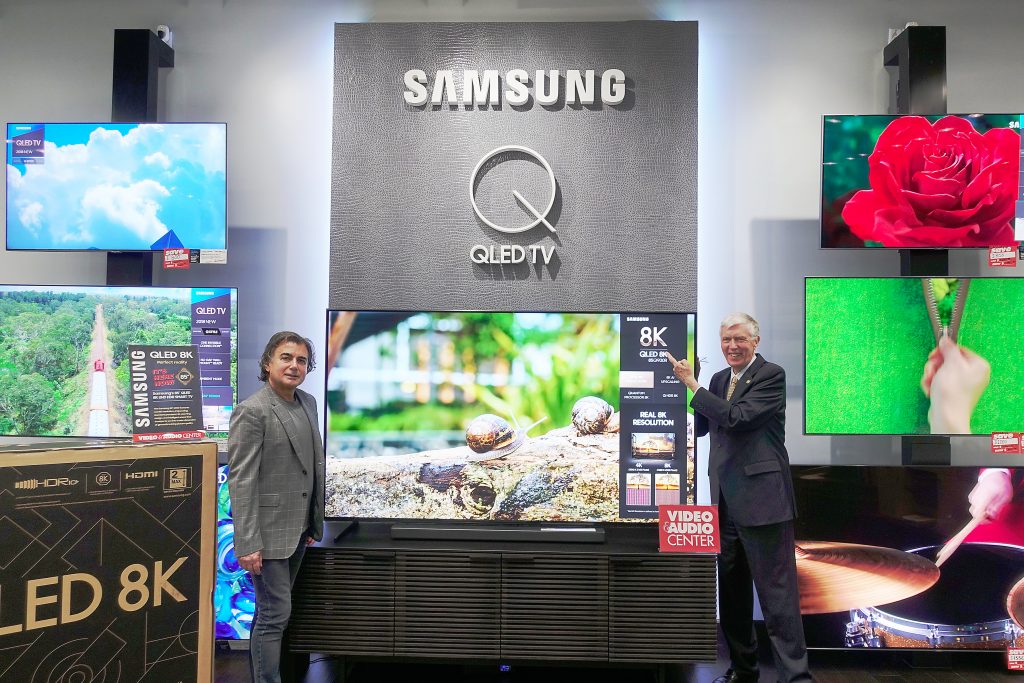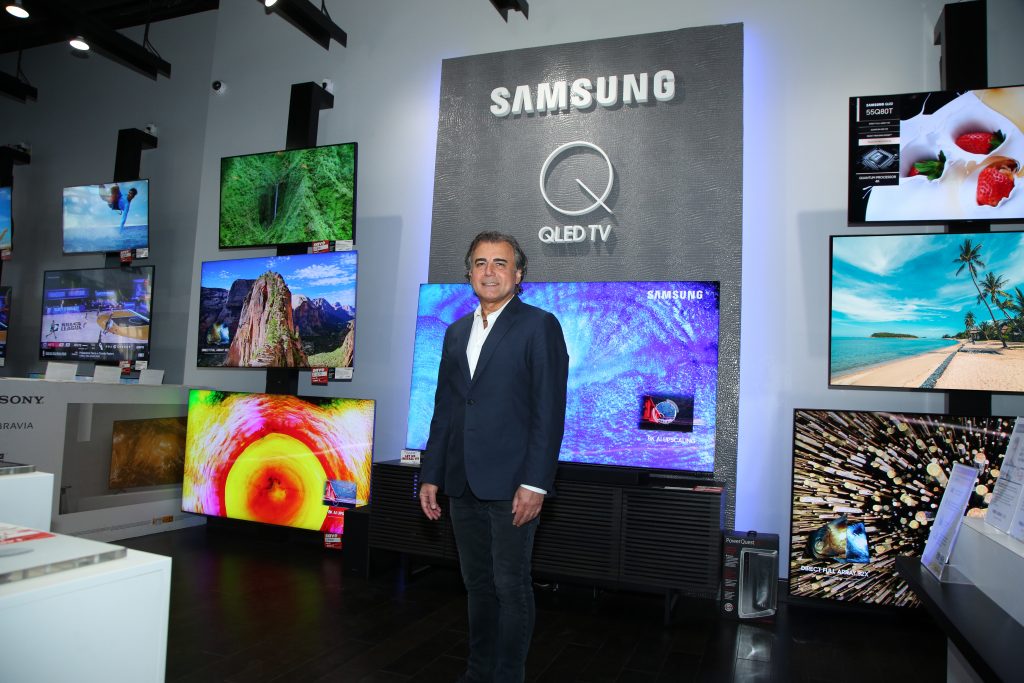What’s the history of Video & Audio Center?
This is our 40th anniversary year — we’ve been around since 1981, which is also the year I came to the U.S. to join my brother, Mayer, who already had a store selling video games and renting out movies. Based on what my customers were asking me about, I realized shortly after joining him that there was more demand for electronics and gadgets. So the very next January, in 1982, we went to our first CES show and realized, my goodness, there are so many gadgets and so many brands — Sony, Fisher, Sanyo, Casio, and Goldstar (LG) — so we signed up for a dealership and shortly after that we became an electronics business.
Back then, there were 800 electronics retailers in L.A. alone, throughout the 1980s. So we had a lot of competitors. Right off the bat, my aim was always to carry the best and to sell solutions rather than try to compete on pricing. Then, about 23 years ago, I saw that electronics were getting more complicated and control systems were growing, so right across the street from the original Video & Audio Center store in Santa Monica, I opened up a 5,000-square-foot showroom specifically aimed at customers who were interested in custom installation. It had a home theater, master bedroom, living room — whatever is in the home, we had built out in the showroom. Over time, we realized that our customers were increasingly aware of custom installation options and did not need to be convinced with a showroom — much better to go right to their home, office, or other job site to assess and then tell them what they need. So about 10 years ago, we closed the showroom location.
A couple of years after that, we noticed that many of our competitors didn’t exist anymore, so we started to open up new locations throughout the Los Angeles area for the first time.
How many stores do you have now?
Right now, we have five locations — superstores in Santa Monica, Lawndale, and Agoura Hills — and smaller showcase boutiques like this one in Century City and Agoura Hills. The store at Westfield Century City, where we are now, is in a prime location near the escalator as people are coming out of the parking garage. In normal times, this mall gets more than 2 million visitors per month, and this area is full of offices — more than 400,000 people work within two blocks of this store. They need gadgets and electronics, and even though many malls haven’t been doing well, this one has flourished because so many people come here to eat. Even over the last 12 months, this has been a well-visited shopping mall because it’s outside and has just undergone a $1 billion renovation. Locations like this one are important for manufacturers, too, because big regional stores that are a destination don’t really exist anymore, so having a showcase like our Century City location for products is a good place for consumers to see what they cannot see online.
In what ways is Video & Audio Center different from the competition?
My aim over the past 40 years has been to concentrate on any level of consumer, whether that consumer wants a $199 50-inch TV or a $400,000 Samsung Wall TV, which we were among the first to install in the U.S. We’ve built many home theaters, which ranged in price from $100,000 to $2 million, as well as underwater audio systems in pools. We’ve built custom solutions for everyone from Elizabeth Taylor and other celebrities to movie studios.
Making things easy has also always been a part of our strategy, especially with custom installation. It’s where our “Just OneTouch” motto came from 23 years ago. We’re also always technology-forward, always staying on top of the cutting edge and carrying the latest products.
I have always led with the idea that price is no objection — I want to bring everything in that exists, as long as there is interest. We have sections in our stores for the latest high-tech products across categories — not just video and audio — from Nest cameras and Dyson vacuums to video game consoles and laptops. Our aim with this and other stores is to provide a place where the consumer comes in, then sees and touches products and gets the same excitement that I and so many other people get when walking the CES show floor. I don’t see online stores, Costco, or Best Buy as competition because they don’t really create that kind of in-store excitement or provide first-class service. For example, if you buy something from us, we’ll do a same-day setup for you. We also have a 24-hour, seven-days-a-week customer hotline in case anything goes wrong with your purchase or you have any questions on how it works.
What is Video & Audio Center’s online or e-commerce approach?
Obviously, online business is not something that’s going to go away, and as you can see, it’s a growing trend. When something like this happens, you have to embrace it. You have to follow the direction of consumer habits. We started our online operation about 10 years ago. We have a beautiful website, and whenever someone buys something online, we quickly send them a message and always follow through with an installation if they’re local. And if they’re not local, then we can reach out to any members of the HTSA, which is the 63-plus-member buying group to which we belong, to help with that installation or any other advice. We do a lot of advertising everywhere, including online, and we get a lot of customers coming in from that — I’d say about 25- to 35 percent of our business comes from online ads, and it’s often new customers who want to see things in person and make sure they work, and often need advice.
Did the pandemic change the way you do business in any way?
Our 24/7 hotline was launched during the pandemic — and as a direct result of it. We’d never had a hotline before, but we figured that customers did not want to come into the store, so we made sure that hotline was all over the media — print, TV, radio, and social media — and we closed many deals over the phone. We had so many people calling us about all kinds of products and realized that we have as many customers interested in 32-inch TVs as we do in million-dollar installations.
Name three things that the management team at Video & Audio Center has implemented that you attribute to the success of the store.
Number One is the weekly training we do for our salespeople. If our salespeople can’t demonstrate products, they should not be on the floor. Number Two is the design of the showrooms. Our stores are set up with a different “store within a store” section for each manufacturer. So when you walk into the store, you visit each brand’s area and see its products, as at a trade show. Number Three would be product selection; we always carry the latest meaningful product, which means it’s part of a growing category— not some hyped trend technology. We also only carry top-tier brands.
What are your goals this year?
Well, in addition to continuing to build on the Video & Audio Center brand, we are launching an additional new motto — ”Just One Whisper” — which complements “Just One Touch,” but also takes into account the enormous growth of voice-activated interfaces for controlling all the devices in the home, including custom installations. Also, with the pandemic subsiding and at least some people heading back to work, we want to get people back into stores to see, touch, and experience the products. Our approach is centered on what I call the three Ds: discovery, desire, and demand. That means getting all the great new products and brands out in front of customers through hyperlocal advertising and enticing in-store displays. My main goal this year is to get manufacturers and their new products right in front of consumers to create the desire and demand.
Do you have any plans to expand in other ways or sell other categories?
Yes, we’re expanding rapidly into the health and wellness category. Obviously, these smart watches and other devices are essential for, say, diabetics who need to know if their blood sugar is high, or anyone who wants to check their blood pressure throughout the day. We’ll be creating health and wellness categories and sections in our stores, and will put some marketing behind them. The advertising will be a little different, such as sending mailers directly to homes and working with doctors and hospitals to get awareness around this category and help it succeed.
Is there anything in the building of your business that did not go the way you expected, and that you learned from?
Well, the best thing I did was create the Just One Touch showroom 23 years ago, which was very successful for nearly a decade, but the worst thing was when I realized after 10 years that it wasn’t necessary anymore. People no longer needed to be convinced to move forward with custom installations; they were just calling and asking for me to come to their homes, spec it out, and come up with a solution. So I had to get rid of it. As a result of closing that location, I learned that business is always evolving and if you don’t evolve, you die. So that practice is now in place every day not only with myself, but also with my marketing people and my buyers: Always look ahead for newer and better technologies and bring those to the consumer in the ways that consumers want.
Where is your favorite section of the store?
I designed this big carousel in the back where every manufacturer — Sony, Samsung, LG — has their TV mounted side by side and people can see what different monitors look like from every angle. When you have a TV on the wall, you don’t see how thin it is. No one else has a beautiful showcase like this.
How does Dealerscope help you in your everyday business?
For years, I’ve made sure that all my employees subscribe, to the point where I used to ask them if they knew what was in Dealerscope in terms of what new TV or technology is coming. So it’s really for awareness — to make sure our people not only know what’s coming in the future, but also what other retailers are doing so we can adapt.


















